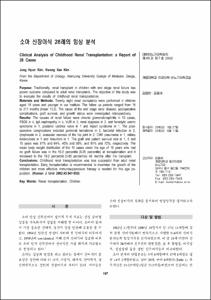소아 신장이식 28례의 임상 분석
- Keimyung Author(s)
- Kim, Kwang Sae
- Department
- Dept. of Urology (비뇨의학)
- Journal Title
- 대한비뇨기과학회지
- Issued Date
- 2002
- Volume
- 43
- Issue
- 7
- Abstract
- Purpose: Traditionally, renal transplant in children with end stage renal failure has poorer outcome compared to adult renal transplants. The objective of this study was to evaluate the results of childhood renal transplantation.
Materials and Methods: Twenty eight renal transplants were performed in children aged 18 years and younger in our institute. The follow up periods ranged from 15 to 217 months (mean 73.2). The cause of the end stage renal disease, postoperative complications, graft survival, and growth status were investigated retrospectively.
Results: The causes of renal failure were chronic glomerulonephritis in 13 cases, FSGS in 4, IgA nephropathy in 4, VUR in 2, renal dysplasia in 2, and hemolytic uremic syndrome in 1, posterior urethral valve in 1 and Alport syndrome in 1. The postoperative complications included perirenal hematoma in 2, bacterial infection in 2, lymphocele in 2, avascular necrosis of the hip joint in 2, CMV pneumonia in 1, miliary tuberculosis in 1 and hirsuitism in 1. The graft and patient survival rate at 1, 5 and 10 years was 81% and 64%, 40% and 88%, and 81% and 72%, respectively. The mean body weight distribution of the 10 cases under the age of 15 years who had no graft failure was in the 10.2 percentile (3-25 percentile) at transplantation and it increased to the 18.2 percentile (3-50 percentile) 46 months after the transplant.
Conclusions: Childhood renal transplantation was less successful than adult renal transplantation. Early transplantation is recommended to maximize the growth of the children and more effective immunosuppressive therapy is needed for this age population. (Korean J Urol 2002;43:547-550)
- Alternative Title
- Clinical Analysis of Childhood Renal Transplantation: a Report of 28 Cases
- Keimyung Author(s)(Kor)
- 김광세
- Publisher
- School of Medicine
- Citation
- 김정현 et al. (2002). 소아 신장이식 28례의 임상 분석. 대한비뇨기과학회지, 43(7), 547–550.
- Type
- Article
- ISSN
- 2005-6737
- Appears in Collections:
- 1. School of Medicine (의과대학) > Dept. of Urology (비뇨의학)
- 파일 목록
-
-
Download
 oak-bbb-1341.pdf
기타 데이터 / 203.19 kB / Adobe PDF
oak-bbb-1341.pdf
기타 데이터 / 203.19 kB / Adobe PDF
-
Items in Repository are protected by copyright, with all rights reserved, unless otherwise indicated.